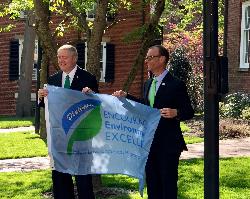
Photo courtesy of: Ohio University Ohio EPA Director Craig Butler (right) and Ohio University President M. Duane Nellis (left) participate in a flag-raising event highlighting the University’s focus on sustainability and being a national leader in campus environmental stewardship.
Ohio EPA Director Craig W. Butler recognized Ohio University with Ohio EPA’s highest environmental stewardship honor during a May 9 flag-raising event that highlighted the University’s focus on sustainability and being a national leader in campus environmental stewardship.
Ohio University is the first university in Ohio to achieve Platinum-level recognition in Ohio EPA’s Encouraging Environmental Excellence (E3) program. OHIO previously earned “Achievement” and “Gold” level E3 recognition.
“Ohio University makes sustainability a priority, putting stewardship and conservation into practice across campus, incorporating sustainability into the curriculum and taking the knowledge and methods to other universities and organizations across the country,” Director Butler said. “As director of Ohio EPA, I am pleased to recognize Ohio University for its environmental leadership.”
Ohio EPA’s E3 program recognizes businesses and other organizations for completing environmentally beneficial activities and serves as an incentive for organizations to commit to ongoing environmental stewardship. Platinum level honors organizations that expand their environmental program beyond their facilities and demonstrate how their environmental stewardship efforts benefit the local community, region or larger geographic area.
“Today’s Ohio EPA recognition underscores Ohio University’s ever-growing national leadership commitment to the environment,” said Ohio University President M. Duane Nellis. “I look forward to OHIO’s continued role as an active state and national leader in sustainability and further serving our community and region by advocating for innovation, research and the fulfillment of the University’s commitments to environmental, social and economic well-being.”
In 2005, Ohio University became the first public institution in Ohio to employ a full-time staff member dedicated to sustainability. OHIO’s Office of Sustainability coordinates event programming for the Sustainable Living Floor in Tanaka Hall and the Ohio University Ecohouse.
The University uses sustainable procurement and green cleaning standards and requires new construction on campus to meet Leadership in Energy and Environmental Design (LEED) Silver standards.
Ohio University has the largest in-vessel composting system at any university in the nation. The University can divert 100 percent of its food waste from landfills by sending it to the compost facility, composting more than 600 tons of organic materials annually. The University also is focusing on local food purchasing and, when possible, donates excess food to a local food bank. In 2017, 15.5 percent of food purchases were from local or sustainable sources.
The University has incorporated sustainability education into its curriculum and is reaching beyond campus, working with the city of Athens and the Appalachian region on sustainability projects, working with the Sugar Bush Foundation to foster sustainable environmental and socioeconomic development. Ohio University sends faculty and staff to speak at regional and national conferences and hosted the first Ohio Sustainability Professionals Summit, bringing together sustainability professionals from 13 institutions of higher learning across Ohio.
One of these projects is an effort to clean up acid mine drainage that pollutes streams in the region’s coal mining communities. The engineering and art departments teamed up to develop a project that turns the orange mineral-laden water into paint pigment for artists. The goal is to clean up streams and create local jobs.
OHIO is diverting more than 60 percent of its solid waste with the goal of becoming a zero waste to landfill organization. As students moved out at the end of the school year, Ohio University partnered with community organizations and Athens to send an estimated 4 tons of food, more than 2,400 articles of clothing and 20 tons of reusable items to help 800 local families rather than sending the unwanted items to a landfill.
To obtain recognition for stewardship, an organization can work through four levels of recognition. In addition to Platinum level, these include Achievement at the base level; Silver Level recognizing outstanding accomplishments in environmental stewardship; and Gold Level recognizing comprehensive environmental stewardship programs. All levels require a commitment to meet or exceed environmental regulatory requirements.
Through the E3 program, Ohio EPA’s Division of Environmental and Financial Assistance helps businesses receive recognition for environmental stewardship efforts. To learn more about the E3 program and the nomination process, visit www.epa.ohio.gov/ohioe3.aspx .

